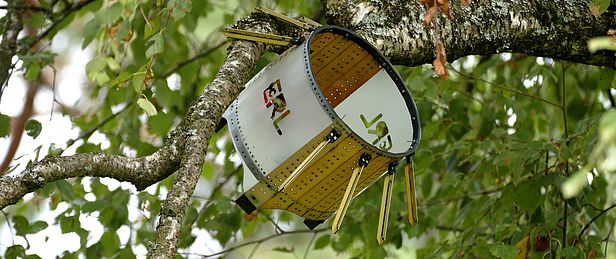17.12.2021 | Gottardo Pestalozzi | News WSL
Researching the environmental conditions in forest canopies requires a head for heights and climbing talent or expensive scaffolding. However, scientists are now also experimenting with special drones. Such flying robots are being developed by a team from the Swiss Federal Institute for Forest, Snow and Landscape Research WSL and ETH Zurich.

A yellow cylinder is approaching the densely leafy maple tree, humming through the air. It flies determinedly towards a branch as thick as an arm. In the process, it brushes through leaves and thin branches. Arriving at its destination, it hangs on, wobbles back and forth briefly and falls silent. What is going on here? An article pubilshed by the journal IEEE Robotics and Automation explains it in great detail.
Monitoring the forest to protect it
Forests cover about one third of the earth's surface, worldwide as well as in Switzerland. They are of enormous importance for biodiversity, climate regulation and ecological balance. In order to study them and protect their ecosystems, data from the treetops is also needed. But because of their height and the leaves and branches that block access, they are difficult for researchers to access. Couldn't drones help? Yes, but...
So far, drones have only been able to collect information by flying overhead. The limited battery life and disturbing noise further limit their use. To overcome such obstacles, researchers at WSL and ETH Zurich have begun to develop drones - actual environmental robots - that imitate the behavior of the creatures that live in the treetops. They must be able to withstand collisions with branches, crawl through cavities, cling to objects, take pictures or deposit sensors. The first product of the team led by ETH professor Stefano Mintchev is HEDGEHOG, a drone that can cling to branches.
Propeller shutdown enables discrete longterm-observation
The HEDGEHOG drone owes its special capabilities to two elements in particular: A cylindrical protective cage and a set of "origami-style" spikes.
The cage houses the propellers and allows safe flight even when contact with leaves and branches is unavoidable. It also serves as a carrier for batteries, microphones, cameras and other sensors as required.
HEDGEHOG holds on to the branch by means of specially coated, movable spikes. These are inspired by the Japanese origami folding technique. When the spikes touch a branch, their lateral folding flaps open to adapt to the irregular branch surface. On their inside, they feature an anti-slip surface that helps support the weight of the drone.
The pilot can put the drone into standby mode via the remote control. With the built-in cameras and microphones, the robot can then observe the events in the crown unobtrusively over a longer period of time, that is record video and audio. When the observation is finished, the drone can be awakened and brought back to the base.
Environmental robotics help to understand the forest ecosystem
With HEDGEHOG and other robotic drones, the development team wants to contribute to a deeper knowledge of life in the treetops. This in turn can be an additional basis for protective measures and silvicultural decisions. The HEDGEHOG prototype was developed by Steffen Kirchgeorg as part of the CYbER (Canopy Exploration Robots) project and was built and tested at the WSL Research Institute in Birmensdorf.
Contact
Project
Publications
Copyright
WSL and SLF provide the artwork for imaging of press articles relating to this media release for free. Transferring and saving the images in image databases and saving of images by third parties is not allowed.
